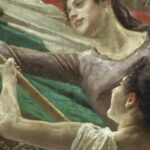"Landscape," "historical and artistic heritage," and "human factor"
In the preceding paragraphs, it was noted how Art. 51 Const. panders to Art. 9 in distinguishing between the Italian Nation and the Republic. The former is a moment of cultural continuity, which lives on through the generations, according to the cue offered by the recent amendment to Art. 9; the latter is the governmental organization, which - Art. 51 specifies - tends to be functional in welcoming "Italians," i.e., those who are part of the Italian Nation: in other words, in the constitutional vision, the State (the "Republic") does not claim to fully encompass the Nation in itself, but certainly constitutes its privileged political space (see again Art. 51), i.e., it is the national State1.
In the preceding paragraphs, it was, likewise, noted that Article 9 catches a glimpse of the constituent features of the Nation - which, on the basis of Articles 1 and 51, can be fully designated as the Italian Nation - in the "landscape" and the "historical and artistic heritage." It follows that, in order to fully grasp the meaning of the reference to the Nation found in the Fundamental Charter, it is necessary to focus on the meaning of these expressions.
It has been agreeably observed that, in the silence of the constitutional text, the source from which to draw the necessary guidance can only be the ordinary legislature: this, in fact, incorporates the most recent interpretations of Article 9 and, at the same time, inspires the jurisprudence2. In this direction, a very important contribution is offered by the Code of Cultural and Landscape Heritage (Legislative Decree No. 42 of January 22, 2004), which - after identifying in Article 2, paragraph 3, landscape assets in the "real estate and ... areas ... constituting an expression of the historical, cultural, natural, morphological and aesthetic values of the territory, and other property identified by or under the law" - specifies with Article 131, paragraph 1, that "landscape means the territory expressive of identity, the character of which derives from the action of natural, human factors and their interrelationships". Also on the basis of these contributions of the ordinary legislator, the Constitutional Court, Nazzicone recalls, has affirmed that protection does not concern only individual elements, but the entire man-made environment, the "landscape, understood as the morphology of the land, that is, the environment in its visual aspect. In essence, it is the very appearance of the land, because of the environmental and cultural contents it contains, that is in itself a constitutional value.".
The indications on which to reflect are neither few nor of little moment.
First of all, the cultural heritage code confirms the territorial rootedness of the concept of Nation, mentioned above. Any doubts in this regard - already put to the test by the concrete American experience, where Calvinist culture had to measure itself against the characteristics of the new continental dimension3- is defused by the aforementioned Art. 131, which in more ways is more explicit than Art. 2, also quoted above. Indeed, Art. 131, taking up motifs shared with the German system4, clarifies that "territory [is] expressive of identity". The latter, which is the foundational aspiration of the concept of "Nation," pursued as well by "nations" whose historical perspective we can hardly grasp5, it escapes the equivocation of a vague abstraction, since - Article 131 cited above continues - "results from the action of natural, human factors and their interrelationships".
It is, therefore, these "interrelationships" between "natural factors" and "human factors" that are the focal point, from which springs the long-standing need, historically witnessed by each human group, for a collective identity.
Upon careful analysis, the plot of such "interrelationships" turns out to be very concrete: man expresses his needs and his way of being; he regulates the conditions of access to the means of survival, production and development; he acts on the surrounding nature and constructs historical experience; he reflects on the latter and on himself, not already in an aseptic and timeless limbo, but in the concreteness of life needs as they are determined in the confrontation with the world that surrounds and challenges him. Hence, on the one hand, the importance of the geographic-territorial-climatic dimension as a conformative element of the vital experience of human groups; while, on the other hand, this path of survival and (eventual) development - punctuated by the legacy that each generation receives from the previous ones and passes on to the next - determines the need for an overall cultural narrative, more or less idealized, more or less wrapped in "myth," in the search for a collective identity, such as to constitute the group, guarantee its cohesion and thus justify its meaning and often also the policies to be followed6: all this - the Constitution confirms to us - in the current legal system is designated by the word "Nation" and - in this respect the Constitutional Court assists - is a "constitutionally protected value."
The "constitutionally protected value": Nation and People
In the preceding remarks, the actual protagonist of the constitutional protection arranged by Article 9 clearly emerges. It is represented by that "human factor," of which, when we transcend from the anodyne expression of Art. 131 code of cultural heritage, we immediately discern the link with the succession of generations, present in the same Art. 9 following the recent reform.
This is the decisive aspect on the value level: in the Nation, protected by the Constitution with Article 9, is reflected the human action that unfolds on the territory in the course of time, imprinting on it the sign of its material existence and its ideal yearnings and thus projecting into the future the testimony of itself. The normative framework leaves no doubt: constitutionally protected good is the "human factor" that lives and enlivens the territory, both at the local level and in the more articulated geographic place called "Italy," in which the Constitution establishes the Nation and to which in several places it makes express reference. And again: constitutionally protected good are, therefore, the men and women, in whom the People referred to in Article 1 Const. consists, who in History enact the Nation. The conclusion is obvious: the latter is a metaphor for those women and men, their collective events, their beliefs, their actions, their faith, their successes, their defeats, their mistakes. If one wants to abstract, it can be said that the constitutionally protected good is the Spirit actualized in the becoming of History and summarized in the word "Nation": a volksgeist, which is not an abstract mythical shadow, but the concrete reflection of that "historical and artistic heritage," which continues, while renewing itself, through the generations.
Nation and cancel culture
One aspect of primary and absolute importance emerges: the "historical and artistic heritage" possesses an intrinsic value that transcends the material element that gives it substance. It, in fact, has a symbolic value in that it represents past generations and the realization of their humanity through processes and in view of ends, which may not necessarily be "fair," but which are certainly "human" in that they are expressions of human beings, with the characteristics and meaning that has been alluded to above: the statue of Attila symbolizes a national hero for the Hungarians and a synonym of savagery for Western Europeans, but nonetheless it represents the glories, sufferings, struggles, beliefs, and sacrifice of human beings. Not differently, the Colosseum is a place of celebration for some and of death for others: for everyone it is the sign of a destiny.
This intrinsic dimension of humanity, proper to the historical and artistic heritage, which Article 9 Const. connotes on a historical and legal level on the coordinates of the protection of the Italian nation, makes clear the "inhuman" nature of the so-called "cancel culture", an objectively ambiguous formula that is evoked here to designate proposals and movements directed at the erasure, removal, etc., of statues, monuments, artifacts, books, writings relating to a past whose assumptions, purposes, etc., are not shared by the groups promoting such demands.
It is not possible to go into the merits of cancel culture here, but it is absolutely necessary to point out that on a legal level it is outside the existing constitutional framework: any design to destroy, remove, or conceal the "historical and artistic heritage" is irreconcilable with the constitutional objective of "protecting" the heritage itself and is therefore constitutionally unlawful. Instead, theoretical criticism under Article 21 Const. is permitted.
"Political decision-making" and citizenship
There is a consensus among scholars that with the French Revolution the concept of "nation" was transformed from an identity connotation of an entire people to a political project aimed at the conquest of sovereignty by the economically and politically active classes and social groups united in "nation," with the result that the latter will also be configured in the "thoroughly modern and anti-capitalist" sense of "democratic nation" (De Fiores). This mission of political projectuality assigned to the "nation" stabilizes in the 19th and 20th centuries: the "nation," even when it will be invoked in its traditional sense as the identity connotation of an entire people, will still be associated with the struggle for the conquest of independence, or for domination, or as the identity element of a state, as happened in recent times in Eastern Europe.
On this basis, it is well understood that attempting to de-emphasize the use in public discourse of the word "nation" by stating that "nation remains one of the most uncertain words in modernity"7, is tantamount to disregarding an issue of constitutional rank, rich, moreover, in repercussions of no small moment, not only with regard to the ideology that (beyond instrumental trivializations) objectively appears to underlie the current constitution, but also on the programmatic level of precise political choices.
In other words, the problem arises of drawing the threads from what has been said so far about the idea of the Nation espoused in the Constitution in order to determine how the Constitution directs the "political relationship between state, nation and people"8. Art. 9 Const. helps to provide a first answer: the political decision taken by the constitutional legislator is that the State (the "Republic") must protect the elements in which - again by explicit constitutional provision - the Nation is defined as the identity pole of ethnic, historical and cultural matrix of Italians.
The ethnic reference does not seem elusive; it is confirmed by Article 51, which extends state protection to "Italians not belonging to the Republic," thereby underscoring the "national" vocation of the Republic outlined by the 1948 Constitution as the political subject of the Italian people.
The importance in this respect of Article 51 Const. cannot be underestimated: the extension of citizenship rights (or some of them) to "noncitizens" is preferentially directed toward "Italians," i.e., people with ethno-cultural and linguistic characteristics proper to the Italian nation. This means that similar favor does not assist the granting of citizenship to "non-Italians." It follows that in these cases the granting of citizenship cannot disregard the requirement - constitutionally posed - of internalization of the identity characteristics of nationality, which is constructed by the Constitution as a founding element of the nation-state.
In this regard, a clarification may come from the example offered by the ways in which citizenship was acquired in ancient Rome, not - obviously - to reproduce its discipline, but to reflect on the underlying criteria. Through the manumissio each private citizen could have his slave acquire the (valuable and prestigious) Roman citizenship at the moment when with an absolutely discretionary decision he freed him. Here it is not the case to evoke the motives behind this peculiar juridical-social mechanism, which are probably connected to the, so to speak, "cobbled-together" origins of the groups that settled over time on the banks of the Tiber. What we are interested in emphasizing here is the extraordinary cultural condition to which the manumissio was subject, which was an instrument, not already of indiscriminate acceptance of the "different," but rather of the acquisition of skills, cultures, and strengths possessed by "non-Romans," of whom, moreover, the loyalty and adherence to the principles of the res publica9 had already been widely tested.
What makes the Roman example significant is that the conferment of citizenship cannot be separated from an assumption of responsibility, which, in turn, is closely linked to the imperative to protect the Nation imparted to the Republic and its laws by Art. 9 and, therefore, constitutes a legally inescapable moment: those who, through the acquisition of citizenship, become part of the Republic cannot disregard the duties and responsibilities of respecting and safeguarding the "set of characteristics and values ... that defines the profound nature [of] the political collectivity" (Campi) and, before that, the human and cultural collectivity in which the Italian Nation is recognized.
1 Crisafulli, Nocilla, op. cit., 805 ss.
2 Nazzicone, L’art. 9 della Costituzione.
3 See De Fiores, Nazione e costituzione, Torino, 2005, 109 s.
4 Cerrina Feroni, Il paesaggio nel costituzionalismo contemporaneo. Profili comparati europei, in federalismi.it.
5 These are the cases of "nationalisms without nations" exemplified by E. Gentile, op. cit.
6 A conspicuous example of a politically driven foundational narrative is offered by the Bible: see Liverani, Oltre Bibbia. Storia antica di Israele, Roma-Bologna, 2012.
7 Thus Belpoliti, Patrioti, nazione e tradimento. Le parole della tradizione missina, in “La Repubblica”, 27 settembre 2022, 9.
8 De Fiores, op. cit., 241.
9 On this subject see Capogrossi Colognesi, Storia di Roma tra diritto e potere. La formazione di un ordinamento giuridico, Bologna, 2014.
Scientific Advisor of the Machiavelli Center for Political and Strategic Studies. Former Head of the Legal Department of a bank, he is currently Full Professor of Civil Law at the University of Milan-Bicocca. Author of six books and about a hundred articles and minor writings on private, commercial, banking, and financial law.








Scrivi un commento